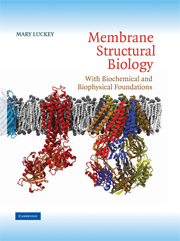Book contents
- Frontmatter
- Contents
- Preface
- 1 Introduction
- 2 The Diversity of Membrane Lipids
- 3 Tools for Studying Membrane Components: Detergents and Model Systems
- 4 Proteins in or at the Bilayer
- 5 Bundles and Barrels
- 6 Functions and Families
- 7 Protein Folding and Biogenesis
- 8 Diffraction and Simulation
- 9 Membrane Enzymes and Transducers
- 10 Transporters and Channels
- 11 Membrane Protein Assemblies
- 12 Themes and Future Directions
- Appendix I Abbreviations
- Appendix II Single-Letter Codes for Amino Acids
- Index
- References
2 - The Diversity of Membrane Lipids
- Frontmatter
- Contents
- Preface
- 1 Introduction
- 2 The Diversity of Membrane Lipids
- 3 Tools for Studying Membrane Components: Detergents and Model Systems
- 4 Proteins in or at the Bilayer
- 5 Bundles and Barrels
- 6 Functions and Families
- 7 Protein Folding and Biogenesis
- 8 Diffraction and Simulation
- 9 Membrane Enzymes and Transducers
- 10 Transporters and Channels
- 11 Membrane Protein Assemblies
- 12 Themes and Future Directions
- Appendix I Abbreviations
- Appendix II Single-Letter Codes for Amino Acids
- Index
- References
Summary
To understand biological membranes, and especially to predict their behavior, requires a detailed knowledge of their components. It is appropriate to start with the lipids that make up the bilayer, because they are not just a solvent providing the “sea” in which membrane proteins float. If this were the case, a few lipidic species would suffice to provide the amphiphilic base of the bilayer and some variation of shapes for packing it. Instead, the diversity of membrane lipids is amazing. A typical biomembrane contains more than a hundred species of lipids, which vary in general structure and in the length and degree of saturation of their fatty acyl chains. This chapter begins with the properties and modulation of the acyl chains and then reviews the structural features of the major complex lipids. It describes the properties of lipid aggregates, including their polymorphism and phase separations, which are the basis of their ability to form lateral microdomains. It addresses the characteristics of lipid rafts in membranes. The chapter ends with studies of lipid metabolism in Escherichia coli that address the biological need for diversity of lipids and support a role for non–bilayer-forming lipids in maintaining the elasticity of the membrane.
THE ACYL CHAINS
When lipids are extracted from a cell with organic solvent, such as a 2:1 mixture of chloroform and methanol, free fatty acids make up only about 1% of the total; most fatty acids are bound covalently in complex lipids.
- Type
- Chapter
- Information
- Membrane Structural BiologyWith Biochemical and Biophysical Foundations, pp. 13 - 41Publisher: Cambridge University PressPrint publication year: 2008
References
- 1
- Cited by



